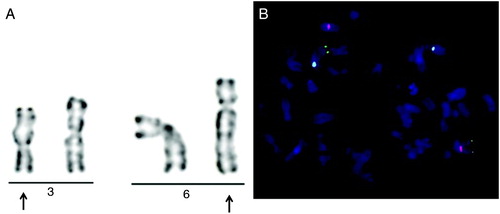Figures & data
Figure 1. Cytogenetic and FISH results of the carrier with balanced reciprocal translocation. A) Partial GTG-banding karyogram showing the t(3;6)(q21;q23) rearrangement. Arrows indicate the abnormal chromosomes. B) FISH analysis on methaphase chromosomes with three color DNA probes for centromeric region of chromosome 3 (CEP3) (red), chromosome 6 (CEP6) (blue), and 3qtel region (green). One green signal (3qter) and one blue signal (CEP6) on the same chromosome confirm the translocation between chromosome 3 and 6.

Table 1. Results of meiotic segregation analysis.
Table 2. Frequencies of 17 and sex chromosomes disomy, diploidy and estimated chromosome anomalies detected by FISH with probes for chromosomes X, Y, and 17 in the patient and mean values in controls and in oligozoospermic men.